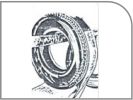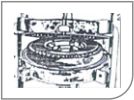HOT PROCESS USING DIE SIZE TREAD RUBBER
In the traditional process of hot cap retreading, an unvulcanised or uncured tread strip is applied on buffed tyre casing, coated with a vulcanisable rubber cement solution. [Fig.I]
The tyre capped with the tread is fitted on a rim with a tube inside and the assembly is placed inside the mould of the retreading press. [Fig.II]
Air pressure given in the inner tube expands the tyre which is inside the hot mould, thereby forcing the unvulcanised tread into the hot cavities of the mould which has a particular tread pattern. Under the influence of temperature and pressure, vulcanisation of the tread takes place, and the new tread forms a firm bond to the tyre casing.

This system, followed since the post war period and perfected over the years, still has certain disadvantages; the major one being the chances for deterioration of the strength of the tyre casing, due to high curing temperature [155 degree to 165 degree C] employed during the moulding process.
Besides, in this process the tyre casing is subjected to too much of stress and strain, thereby giving chances for weakening of the tyre casing. Despite these limitations, tyres retreaded in the hot process are found to give exceptionally good mileage when superior quality treads are used, and correct retreading techniques are employed.

